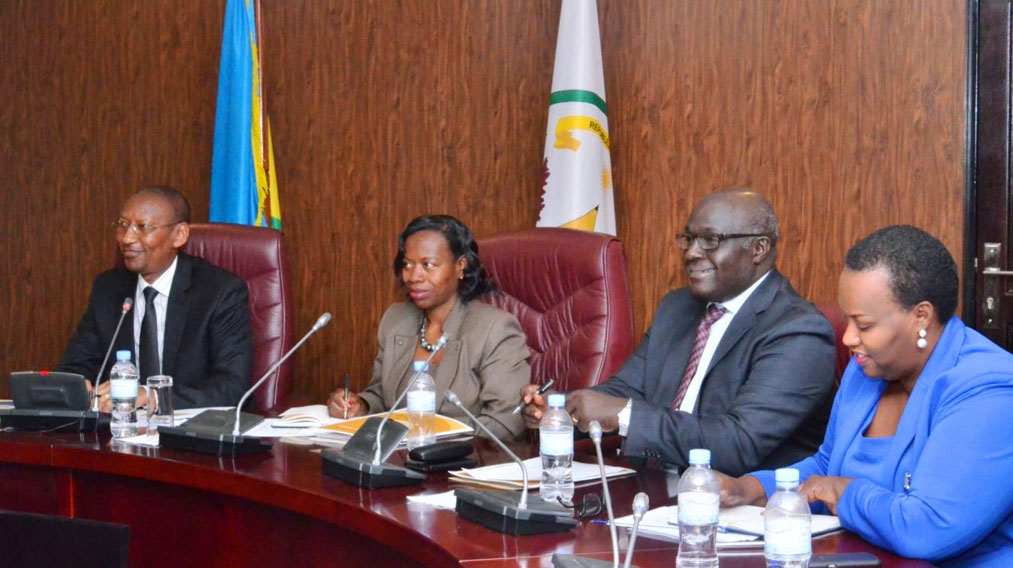
Central Bank senior officials
BNR announced Thursday that the quarterly Monetary Policy Committee (MPC) meeting which was held on April29 to assess recent economic developments at global and national level decided to reduce the CBR to facilitate banks to lend more as a measure to resuscitate the economy in the wake of global economic challenges caused by the COVID-19 pandemic.
The CBR is the lowest rate of interest which BNR charges on loans to banks which is reviewed regularly by the MPC, also known as the key repo rate.
The move is the latest in a number of measures taken by the Central Bank to cushion the economy from the pandemic which is expected to leave many economies across the globe limping.
“The MPC assessed recent negative economic developments, the unfolding impact of previous policy measures and the outlook of the economy. Considering that inflation is projected to decelerate in the second half of 2020 owed to a drop in aggregate demand, the MPC decided to cut the Central Bank Rate (CBR) from 5.0 percent to 4.5 percent,” the statement by the BNR Governor and chair of MPC John Rwangombwa said.
BNR said the decision along with other implemented policy measures taken in March will support commercial banks to continue financing the economy.
Earlier in March, measures to ease liquidity conditions in the banking sector were announced and according to the Central Bank, they yielded immediate impact.
The national bank said so far Rwf23.4 billion has been injected into the system. This was done on April 1, through a reduction of the reserve requirement ratio from 5 percent to 4 percent. The bank says a Rwf50 billion lending facility is also available to banks at the new CBR.
BNR also eased prudential requirements to exceptionally allow banks to restructure outstanding loans of borrowers facing temporary cash flow challenges arising from the COVID-19 pandemic.
As a result, as of April 10, banks had restructured 7,952 loans (out of 8,667 applications) worth about Rwf255 billion in a move aimed at easing pressure on clients.
Taking note of the global situation, the MPC observed that global economic growth is projected to decline sharply by -3 percent in 2020, a downward revision from a 3.3 percent growth previously projected by the International Monetary Fund (IMF) in January.
“This severe economic downturn is a result of the effect of the COVID-19 pandemic that has claimed over 200.000 lives, with more than 3 million cases reported globally to date, leaving many economic activities restricted and countries in lockdown over the past few weeks,”
“Across the world, this outbreak has caused major disruptions in supply chains, uncertainties and high volatilities in financial markets. the contraction in economic activities, high unemployment rates, and a sharp decline in commodity prices,” the bank said.
Tough times ahead
Though Rwanda’s domestic economic performance and outlook had remained strong until COVID-19 outbreak, BNR projects tumultuous months ahead.
“The global economic disruptions caused by the COVID-19 pandemic are weighing on Rwanda’s economy. Leading Indicators suggest that the performance of the domestic economy was strong in the first two months of 2020,” the Central Bank said.
The composite index of economic activities was growing by 5.1percent in the first quarter of 2020 according to BNR but the outbreak of Coronavirus in mid-March 2020 led to a significant slowdown, mainly in the services and industry sectors.
The National Bank says that while the outstanding credit to the private sector increased by 4.3 percent in the first quarter of 2020, the demand for loans reduced due to the decline in economic activities.
“This led to a reduction in new authorized loans by 10.6 percent in 2020 Q1. On the external sector, the trade deficit deteriorated by 18.8 percent in 2020Q1 due to higher imports compared to exports,”
“However, policy measures being taken by the government aiming at supporting the recovery of the economy after COVID 19 are expected to increase the demand for credit by the private sector. This expected recovery will also contribute to a reduction in the trade deficit and maintain a stable foreign exchange market,” the national bank said.
As a result, the headline inflation for the second quarter of 2020 is expected to decelerate compared to the first quarter.
“The average quarterly headline inflation for 2020Q1 stood at 8.2 percent. mainly attributed to increased food and energy inflation,”
“However, due to a significant drop in aggregate demand that resulted from COVID19, headline inflation is projected to decelerate, leading to an average of 6.0 percent and 1.0 percent for 2020 and 2021. respectively pointing out the need for policy measures to support aggregate demand in the economy,” BNR said.
The measures by the MPC are aimed at mitigating the shock on the country’s economy and also ease liquidity conditions in the banking sector and support economic recovery efforts in 2020 and onwards.

